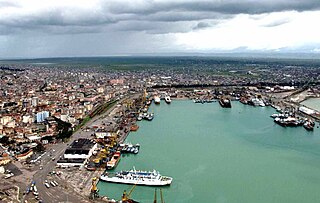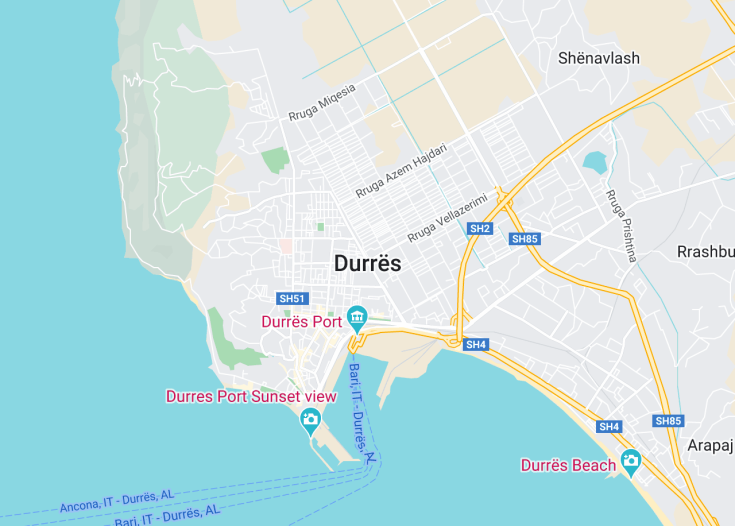Durrës, one of Albania’s oldest cities, located on the Adriatic coast, offers a rich tapestry of historical and cultural experiences. From the well-preserved Roman amphitheater to the bustling Durrës Beach, this city is a fascinating blend of ancient history and modern life. Visitors can explore archaeological sites, enjoy local cuisine at seafront cafés, and visit museums that showcase its storied past. The unique combination of historical landmarks, vibrant local culture, and scenic beaches makes Durrës a captivating destination for travelers seeking both relaxation and adventure in their journeys.
Remember to visit the Roman amphitheater early in the morning to avoid the crowds and experience the historical site in a more serene atmosphere.
Always check local dining hours as many restaurants in Durrës might close in the afternoon between lunch and dinner services.
Top things to do & see in Durrës
Select the following sights and activities to discover best tickets and tours available in Durrës.
Durrës: Gateway to the Adriatic
| Country | Albania |
| Time in Durrës | GMT+1 |
| Language spoken | Albanian |
| Population | 204,299 (World Population Review, 2023) |
| Currency | Albanian lek (Lek, ALL) |
| Airports |
|
Durrës, one of Albania’s oldest cities, sits on the coast of the Adriatic Sea and is rich in historical significance. Known primarily for its ancient origins dating back to 627 BC, Durrës has always been considered the gateway to the Western world. The city’s vibrant past is most evident in its archaeological sites, including the Roman amphitheater from the 2nd century AD, which is among the largest in the Balkans.
Today, Durrës is not only a center for culture and history but also a thriving modern city. Its port, the largest in Albania, serves as a vital hub for both commerce and tourism. The city’s economy benefits significantly from its strategic location, facilitating trade and communication with Italian and Balkan cities via the Adriatic Sea. Moreover, Durrës is known for its beautiful beaches and seaside promenade, making it a popular destination for both local and international tourists seeking relaxation and entertainment.
The cultural heritage of Durrës is preserved in several museums, notably the Archaeological Museum, which houses artifacts from the city’s extensive antique history. The diverse architecture, ranging from ancient Roman remnants to modern buildings, reflects the city’s long and varied history, influenced by its occupation by various powers, including the Romans, Byzantines, and Ottomans.
In addition to historical treasures, Durrës is also rich in culinary delights, offering traditional Albanian cuisine along with fresh seafood from the Adriatic. Its annual summer festivals attract visitors who are eager to experience the local culture, music, and art. The warm and welcoming nature of Durrs’s residents, combined with the city’s historical charm and natural beauty, makes it a unique place to visit and explore.
Where is Durrës?
Durrës is located on the western coast of Albania along the Adriatic Sea, roughly 33 kilometers west of the capital, Tirana.
Distances:
| Route | Distance by car | Time by car |
|---|---|---|
| Tirana to Durrës | 37 km | 40 min |
| Shkodër to Durrës | 102 km | 1 hr 35 min |
| Elbasan to Durrës | 60 km | 1 hr 10 min |
What is Durrës famous for?
Durrës is renowned for its ancient archaeological treasures, notably the Roman amphitheater, and its vibrant port, the largest in Albania, which plays a crucial role in the country’s economy and tourism.
History
Before 627 BCE – Prehistoric and Early Settlements
The area now known as Durrës, Albania, was inhabited by various Illyrian tribes, which were known for their fierce resistance against foreign invaders. Archaeological findings suggest early settlement activities, but it wasn’t until the Greeks established Epidamnos in what is today Durrës around 627 BCE that the city began to take a more defined shape.
627 BCE – 30 BCE: Greek and Roman Influence
Following its foundation by the Greeks, Durrës soon became a thriving hub due to its strategic location along the Adriatic coast. It was renowned for trade and commerce. In 229 BCE, the Romans captured the city and renamed it Dyrrhachium. It served as a vital link in the Via Egnatia, connecting Rome with Byzantium.
30 BCE – 395 CE: A Prominent Roman City
During Roman rule, Durrës flourished with grand constructions such as the amphitheater, baths, and forums. The city became one of the most important ports in the Adriatic Sea, instrumental in the expansion of the Roman Empire through the Balkans.
395 – 1400s: Byzantine Period and Medieval Conquests
With the division of the Roman Empire, Durrës fell under Byzantine control. Over the centuries, it faced numerous invasions, including those by Bulgarians, Normans, and Venetians, reflecting its significance in the Adriatic maritime routes. Despite these upheavals, Durrës remained a cultural and economic center in the region.
1400s – 1912: Ottoman Rule
Durrës became part of the Ottoman Empire in the late 14th century. Under Ottoman administration, it became a key port and a center for Islamic culture in the region. However, the city’s importance declined due to shifts in trade routes and frequent conflicts.
1912 – Present: Modern Era
Albania declared its independence in 1912, and Durrës played an important role as a political and cultural center. Throughout the 20th century, the city experienced significant development, surviving World War II and the tough communist era. Today, Durrës is recognized for its rich heritage and serves as a vital economic portal in Albania, continually shaping its historical and modern identity.
Visit Durrës
What to see and do in Durrës, Albania
Durrës, one of Albania’s oldest cities, offers a plethora of historical sites alongside beautiful coastal views. Key attractions include:
- The Roman Amphitheater, one of the Balkans’ largest ancient remnants, provides a peek into the city’s illustrious past.
- The Archaeological Museum showcases artifacts that narrate the rich history of Durrës from ancient to medieval times.
- The Venetian Tower and city walls, which exemplify the medieval defensive architecture of the area.
- Enjoy the sandy beaches and vibrant promenade along the Adriatic coast, perfect for relaxation and leisure activities.
Events in Durrës
Durrës hosts several cultural events, particularly during the summer months when the city comes alive with festivals. The Durrës Summer Festival, taking place in August, features a variety of music, dance, and food that highlights local and national culture.
Best time to visit Durrës
The ideal time to visit Durrës is between late spring and early autumn, from May to September, when the weather is warm and the city’s cultural activities are most vibrant.
Is Durrës worth visiting?
Without a doubt, Durrës is worth a visit. Its rich historical tapestry combined with its picturesque Adriatic coastline offers a unique blend of exploration and relaxation. Whether you are a history buff or a beach lover, Durrës provides a captivating experience that caters to a wide range of interests, making it a must-visit destination in Albania.










